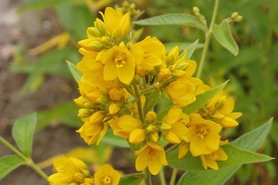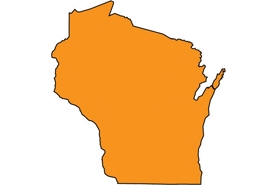Garden yellow loosestrife
(Lysimachia vulgaris)
Herbaceous perennial wetland invader with yellow flowers. Closely related to the aggressive invasive plant, purple loosestrife.
Other names for this plant include:
- Common names: garden loosestrife, willowweed, and willowwort
- Scientific names: None.
Classification in Wisconsin: Restricted
- Ecological Threat
-
- It invades wet areas including wetlands, marshes, stream edges, lakes and fens.
- Invasive throughout much of the United States. It was banned from sale in Connecticut and Washington state.
- Seeds can remain viable in the soil for up to 20 years.
- Plants reproduce both vegetatively and by seed.
- Identification
-
Leaves & stems: Lanceolate-shaped leaves are arranged whorled or opposite along erect stems. The undersides of the leaves are softly hairy. Leaves have dot markings.
Flowers: Inflorescence is terminal on the stalks and leafy. The small yellow flowers have five petals.
Fruits & seeds: Egg-shaped capsules contain a few seeds.
Roots: Long rhizomes creep along the soil surface.
Similar species: There are several native wetland plants in the same family as garden yellow loosestrife with yellow flowers (L. quadrifolia, terrestris, ciliata and lanceolata). Many of these do not have dots on the underside of the leaves. Garden yellow loosestrife is similar to its well-known invasive cousin, purple loosestrife (Lythrum salicaria), with different colored flowers and can invade similar habitats.
- Control
- Mechanical:
- Hand-pull individual plants. Be sure to remove the entire rhizome. Monitor for re-growth.
- Cover infestations with black landscape fabric for a minimum of one entire growing season.
- If populations are found near water, be sure to use aquatically-approved herbicides.
- Glyphosate, triclopyr and imazapyr have all been reported as effective.
- Resources
- Sources for content:
- USDA Plants Profile
- New England Invasive Plant Atlas
- Washington State Department of Ecology



